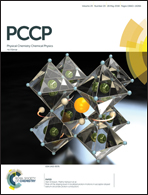Chelated metal ions modulate the strength and geometry of stacking interactions: energies and potential energy surfaces for chelate–chelate stacking†
Abstract
Quantum chemical calculations were performed on model systems of stacking interactions between the acac type chelate rings of nickel, palladium, and platinum. CCSD(T)/CBS calculations showed that chelate–chelate stacking interactions are significantly stronger than chelate–aryl and aryl–aryl stacking interactions. Interaction energy surfaces were calculated at the LC-ωPBE-D3BJ/aug-cc-pVDZ level, which gives energies in good agreement with CCSD(T)/CBS. The stacking of chelates in an antiparallel orientation is stronger than the stacking in a parallel orientation, which is in agreement with the larger number of antiparallel stacked chelates in crystal structures from the Cambridge Structural Database. The strongest antiparallel chelate–chelate stacking interaction is formed between two platinum chelates, with a CCSD(T)/CBS interaction energy of −9.70 kcal mol−1, while the strongest stacking between two palladium chelates and two nickel chelates has CCSD(T)/CBS energies of −9.21 kcal mol−1 and −9.50 kcal mol−1, respectively. The strongest parallel chelate–chelate stacking was found for palladium chelates, with a LC-ωPBE-D3BJ/aug-cc-pVDZ energy of −6.51 kcal mol−1. The geometries of the potential surface minima are not the same for the three metals. The geometries of the minima are governed by electrostatic interactions, which are the ones determining the positions of the energy minima. Electrostatic interactions are governed by different electrostatic potentials above the metals, which are very positive for nickel, slightly positive for palladium, and slightly negative for platinum.



 Please wait while we load your content...
Please wait while we load your content...